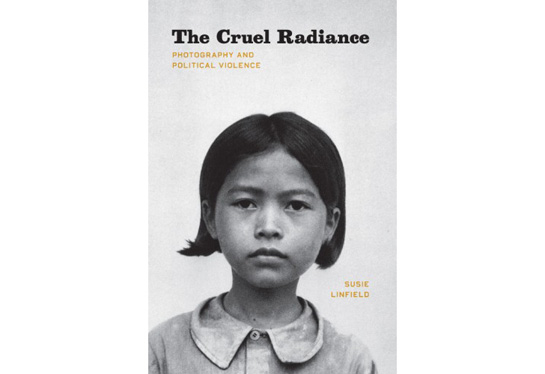Review: The Cruel Radiance by Susie Linfield

Good critical writing about photography is rare. By “good” I don’t mean someone’s ability to conform to what is widely considered the standard of such writing, namely to reference ad nauseam the usual essays by Susan Sontag, Roland Barthes, and/or Walter Benjamin - the Procrustean Bed of critical writing about photography. By “good” I mean first, to write in a way that makes the text enjoyable because of its elegance, and second, to provide insights that extend beyond that which we already take for granted. The Cruel Radiance: Photography and Political Violence by Susie Linfield easily passes that bar. It is also a book that is long overdue. (more)
Here’s the big question: Why is photography so impotent in the face of violence? We all want to believe that images of violence, of death and destruction, will make their causes - war, injustice, cultural violence - more unlikely. But as is obvious after more than a hundred years of humans seeing photographs of war and atrocities that is simply not the case. For all big questions, of course, there are simple answers. Here it is: Seeing images of violence makes us care less, because we shut off. Add to that the so-called “postmodern” criticism of photography, and you got the perfect predicament: We all know that there is a problem, yet we can’t solve it.
Unless, that is, we’re willing to look at things from a somewhat different angle - which is exactly what Linfield does in her book. The first dozen pages of the book have been published online, for example here, and they will give you a good idea what to expect from the rest of the chapter:
I am writing […] against the work of Sontag’s postmodern and poststructuralist heirs and their sour, arrogant disdain for the traditions, the practice, and the ideals of documentary photography. Unlike those critics, I believe that we need to respond to and learn from photographs rather than simply disassemble them.” (p. xiv f.)And later
It’s hard to resist the thought that a very large number of photography critics - including the most influential ones - don’t really like photographs, or the act of looking at them, at all. (p. 5)Tracing postmodern criticsm back to some of its roots, Linfield deftly and elegantly demonstrates why it is so flawed, to conclude with the following zinger
Though most contemporary photography critics - or at least those I have discussed - identify themselves with the left, their loathing of photography is not a subversive stance. It aligns them, in fact, with the forces of deploable backwardness: with, for instance, the frenzied crowds in Kabul and Karachi, Damascus and Teheran, who called for the execution of the Danish cartoonists. Here - in the hatred of images and the lust to police our imaginations - is where premodernism and postmodernism merge. For those demonstrators, too, regard images as an exploitation, an insult, a blasphemy: as an imperialist “act of subjugation” indeed. (p. 30)Ouch!
How then, if not following those postmodern models, to talk about photography and suffering, photography of suffering and war and cruelty and violence? Having brushed our own intellectual mullahs aside, this is what constitutes the bulk of The Cruel Radiance. The second chapter discusses photojournalism and human rights. Is it wrong to show images of suffering? It’s a simple question, but it makes even more sense to ask
What is wrong with revealing such suffering: what is right with hiding it? Why is the teller, rather than the tale, considered obscene - and in any case, aren’t some of the world’s obscenities worthy of our attention? (p. 41)One could mistake this question with a desire to simply see everything. But as becomes abundantly clear from many of the chapters in the book, Linfield is fully aware of those consequences. After this second chapter, which urges us to see, each and every remaining one is filled with discussions of images showing the most gruesome events on this planet. Often, this includes very personal and emotional revelations, without them becoming the center of the debates. If anything, The Cruel Radiance is centered on how we might only make some progress talking about photography of suffering if we don’t brush empathy and emotions aside - not to have them overwhelm the discourse, but rather to grant them the space they deserve.
With two large sections, one entitled Places, the other one People, Linfield discusses photographs from the Killing Fields or from Auschwitz, and she talks about the photography of Robert Capa, James Nachtwey, and Gilles Perress. As much as I occasionally disagree with the author, especially in the chapters about the individual photographers, each and every part of this book deserves to become part of the required reading list of a photojournalist, critic, or photography student. Much has been written about Capa, Nachtwey, and Perress, Linfield effortlessly adds a new voice (just as an aside Nachtwey’s studio’s refused to grant permission for the reproduction of his images - go figure).
I’m hoping that there will be more books like The Cruel Radiance. I hope the path it has formed will turn into a solid road, especially since we live in a world dominated by images, overwhelmed by images - yet, ironically, due to the efforts of so many photography critics, we seem to lack the ability to discuss these photographs, to talk about what they mean, what they might make us do, what they fail to make us do and why. Photojournalism is dead - so we are told; but after reading Linfield’s book it is obvious that the opposite is the case, and it is obvious why we need photojournalism and what we need it for.
The Cruel Radiance is a most brilliant achievement.